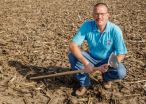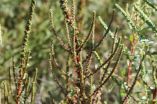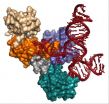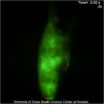(Press-News.org) CHAMPAIGN, Ill. — An invasive weed that has put some southern cotton farmers out of business is now finding its way across the Midwest – and many corn and soybean growers don't yet appreciate the threat, University of Illinois researchers report.
Palmer amaranth (Amaranthus palmeri), a flowering plant native to the Sonoran desert and southwest United States, has a laundry list of traits that make it a fierce competitor on the farm, said Aaron Hager, a University of Illinois crop sciences professor.
Palmer amaranth germinates throughout much of the growing season, starts earlier and grows faster than other weeds, and is a prolific seed producer, Hager said. It can tolerate drought and heat extremes that would kill other plants. And it is becoming resistant to the most common herbicides used to combat it, he said.
Killing the plant before it can go to seed is the best way to control it, he said. That means treating young plants with herbicides when they are less than 4 inches tall.
"Once it is taller than 4 inches, the effectiveness of herbicide treatments drops off very dramatically and very quickly," Hager said.
Catching the plant that early is problematic, however. As a seedling, Palmer amaranth looks a lot like waterhemp, another problematic weed that is difficult to control. This means farmers have the dual challenge of determining whether Palmer has invaded their fields and, if it has, taking effective action to kill it before it takes over.
"In other parts of the U.S., this species has devastated cotton production and in many areas, especially in Georgia, it was not uncommon to see cotton fields literally mowed down to prevent this weed from producing seed," Hager said. Some growers who failed to recognize the threat lost their farms as a result, he said.
Preventing a Palmer amaranth takeover also comes at a cost, however. In 2010, for example, Southeast Farm Press reported that the cost of weed control efforts on Georgia farms had risen from $25 per acre to $60 to $100 an acre in response to Palmer amaranth invasions. The state spent at least $11 million in 2009 to manually remove Palmer amaranth from 1 million acres of cotton, "something not normally done," the magazine reported.
Adam Davis, a researcher with the U.S. Department of Agriculture Agricultural Research Service and a professor of crop sciences at the U. of I., reported at a recent agricultural conference that Palmer amaranth can reduce soybean yields by 78 percent and corn yields by 91 percent. Illinois, a state with a $9 billion agricultural commodities market and 80 percent of its land area devoted to farming (mostly corn and soybeans), could see significant losses associated with fighting – or failing to properly fight – this weed, Hager said.
"If you think about the value of agronomic row crops in this state, that's why we're very, very concerned about how devastating this could be to us," he said.
So far, researchers have confirmed the presence of Palmer amaranth in more than two dozen Illinois counties, from the southern tip of the state to Will County, about 50 miles south of downtown Chicago. In about half of those counties, the weed is already resistant to glyphosate, the most commonly used herbicide on Midwest farms, Hager said.
The plant grows so quickly and so tall that it can completely obscure low-growing crop plants. Some soybean fields in Kankakee County, Illinois, became so overgrown with Palmer amaranth that the soybeans were barely visible to the eye.
Many farmers think they can use the same techniques that tend to work against other common weeds – a onetime application of glyphosate herbicide, for example – to control Palmer amaranth, Hager said. This assumption could endanger their farms.
"There is not one magic herbicide that a farmer could use one time and be done with it," he said. "It doesn't work that way."
And if the weed gains a foothold in planted fields, corn and soybean growers in Illinois should take a tip from Georgia cotton farmers and do everything possible to remove the plants, he said. Not a single plant should be tolerated.
"We have to set the threshold at zero. It has to be zero," Hager said. "It's hard to imagine another weed species that would be more injurious to crop production than what this one will be."
INFORMATION:
The U. of I. has set up a service to help farmers identify the plant in their fields and test whether it is resistant to common herbicides. They also published a series of guidelines for controlling the plant.
Editor's notes: To reach Aaron Hager, call 217-333-4424; email hager@illinois.edu.
Palmer amaranth threatens Midwest farm economy, researchers report
2014-06-03
ELSE PRESS RELEASES FROM THIS DATE:
Toxic computer waste in the developing world
2014-06-03
As the developing world continues to develop, standards of living and access to technology increases. Unfortunately, as personal computers, laptops and mobile phones become increasingly common so the problem of recycling and disposal of such devices when they become technologically obsolete rises too, according to research published in the International Journal of Environmental Technology and Management.
Neelu Jain of the PEC University of Technology, in Chandigarh and Pamela Chawla of the Surya World, Surya World Technical Campus in Punjab, India, have estimated the ...
Nano-platform ready: Scientists use DNA origami to create 2-D structures
2014-06-03
Scientists at New York University and the University of Melbourne have developed a method using DNA origami to turn one-dimensional nano materials into two dimensions. Their breakthrough, published in the latest issue of the journal Nature Nanotechnology, offers the potential to enhance fiber optics and electronic devices by reducing their size and increasing their speed.
"We can now take linear nano-materials and direct how they are organized in two dimensions, using a DNA origami platform to create any number of shapes," explains NYU Chemistry Professor Nadrian Seeman, ...
Scientists capture most detailed images yet of tiny cellular machines
2014-06-03
MADISON, Wis. — A grandfather clock is, on its surface, a simple yet elegant machine. Tall and stately, its job is to steadily tick away the time. But a look inside reveals a much more intricate dance of parts, from precisely-fitted gears to cable-embraced pulleys and bobbing levers.
Like exploring the inner workings of a clock, a team of University of Wisconsin-Madison researchers is digging into the inner workings of the tiny cellular machines called spliceosomes, which help make all of the proteins our bodies need to function. In a recent study published in the journal ...
Preventive services by medical and dental providers and treatment outcomes
2014-06-03
Alexandria, Va., USA – The International and American Associations for Dental Research (IADR/AADR) have published a paper titled "Preventive Services by Medical and Dental Providers and Treatment Outcomes." Nearly all state Medicaid programs reimburse non-dental primary care providers (nDPCPs) for providing preventive oral health services to young children; yet, little is known about how treatment outcomes compare to children visiting dentists. This study compared the association between the provider of preventive services (nDPCP, dentist or both) to Medicaid-enrolled children ...
New Ichthyosaur graveyard found
2014-06-03
Boulder, Colo., USA – In a new study published in the Geological Society of America Bulletin, geoscientists Wolfgang Stinnesbeck of the University of Heidelberg and colleagues document the discovery of forty-six ophthalmosaurid ichthyosaurs (marine reptiles). These specimens were discovered in the vicinity of the Tyndall Glacier in the Torres del Paine National Park of southern Chile. Among them are numerous articulated and virtually complete skeletons of adults, pregnant females, and juveniles.
Preservation is excellent and occasionally includes soft tissue and embryos. ...
Miniature digital zenith telescope for astronomy and geoscience
2014-06-03
As a kind of ground-based optical astrometric instrument, zenith telescope observes stars near zenith, which substantially reduces the influence of normal atmospheric refraction. Its high-precision observations can be used to calculate astronomical latitude and longitude, which are mainly applied in mobile measurement for deflection of the vertical, long-term measurement for the variations of the vertical, and related researches of astronomical seismology. Utilizing CCD camera, high-precision tiltmeter and other new technologies and devices, Chinese researchers have successfully ...
Image release: A violent, complex scene of colliding galaxy clusters
2014-06-03
Astronomers using the Karl G. Jansky Very Large Array (VLA) and the Chandra X-Ray Observatory have produced a spectacular image revealing new details of violent collisions involving at least four clusters of galaxies. Combined with an earlier image from NASA's Hubble Space Telescope (HST), the new observations show a complex region more than 5 billion light-years from Earth where the collisions are triggering a host of phenomena that scientists still are working to understand.
The HST image forms the background of this composite, with the X-ray emission detected by Chandra ...
In utero exposure to antidepressants may influence autism risk
2014-06-03
PHILADELPHIA (June 2, 2014) – A new study from researchers at Drexel University adds evidence that using common antidepressant medications during pregnancy may contribute to a higher risk of autism spectrum disorders (ASD) in children, although this risk is still very small.
Results from past studies of prenatal use of selective serotonin reuptake inhibitors (SSRIs) and ASD risk have not been consistent. An ongoing challenge in this line of research is trying to tease apart potential effects of the medication on risk from the effects associated with the condition for ...
Breaking down barriers
2014-06-03
The Gobi-Steppe Ecosystem is world renowned for its populations of migratory ungulates, which cover great distances in search of forage. Researchers at the Research Institute of Wildlife Ecology at Vetmeduni Vienna have documented, that in just one year an individual wild ass can range over an area of 70,000 km2. "Wild asses and gazelles have to be permanently on the move and travel very long distances to find enough food. Rainfall is highly variable in this region. As a consequence pastures are patchy and unpredictable in space and time," explains Petra Kaczensky, one ...
Lasers and night-vision technology help improve imaging of hidden lymphatic system
2014-06-03
VIDEO:
This is a movie illustrating the lack of lymphatic flow in the lower leg of a subject with lymphedema.
Click here for more information.
WASHINGTON, June 3, 2014—The human lymphatic system is an important but poorly understood circulatory system consisting of tiny vessels spread throughout the body. This "drainage" network helps guard against infections and prevents swelling, which occasionally happens when disease or trauma interrupts normal lymphatic function. Chronic ...






